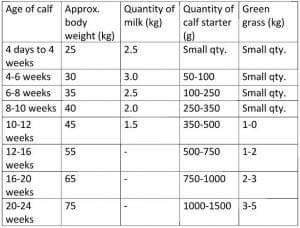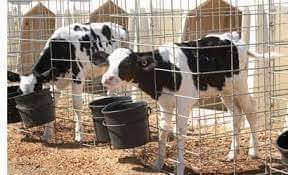SYSTEMS OF CALF FEEDING & CALF MANAGEMENT
The system of calf feeding depends upon the type of feed material used for raising the calf. The following systems are conventionally followed:
• Raising on whole milk
• Raising on skim milk
• Raising on fluids other than milk, such as fresh butter milk, fresh sweet whey, gruels etc
• Raising on milk substitutes
• Raising on calf starters
• Raising on nurse cows
Raising calves on whole milk
• The nutrient requirements of the young calf at 0 to 3 months of age, with an average body weight of 50 kg are as follows
Dry matter 1.43 kg
Total digestible nutrients 1.60 kg
crude protiens 315 g
• It may be noticed that the TDN requirements are larger than the DM requirements, because of high proportion of fat in the diet. At 15 days, the young calf starts nibbling some grass, about half kg per day which is increased to 5.0 kg at 3 months.
• Instead of green fodder, 1-2 kg of good quality hay can be calf meal during this period, beginning with 0.5 kg at 15 days of age, which may be raised to 1.5 kg at 3 months of age.
• From 3 weeks onwards, if the whole milk availability is less, it can be replaced partially with skin milk, butter milk or any other fluid milk substitute.
The calf mixture
• The calf mixture is a concentrate supplement for the young calf, which is being raised on milk or other fluid substitute. The calf mixture chiefly consists of grains such as maize and oats.
• Grains such as barley, wheat and sorghum also can be used in the mixture. Cane molassess can be used to an extent of 10% in the calf mixture.
• An ideal calf mixture contains 80% TDN and 22% CP.
Roughage for the young calf
• Fine stemmed leafy leguminous hay is the best roughage for the yound calf. Hay can be offered from two weeks of age onwards. A legume plus grass mixed hay is also valuable.
• Sun-cured hay which possesses a fresh green colour is a good source of Vitamins A and D as well as B-complex vitamins.
• At 6 months of age, a calf eats 1.5 to 2.25 kg hay. The quantity increases with age.
• Silage can be given additionally in small quantities at 6 to 8 weeks onwards. Feeding of silage too early will cause scours.
• Silage is not the preferred roughage for the calf until it reaches 4 to 6 months of age.
• Maize and sorghum silages which are most common are not rich in protein and calcium and are also low in vitamin D.
Raising calves on nurse cows
• A cow which yields a low fat milk and a hard milker by nature can be successfully employed to nurse 2 to 4 orphan calves right from the first week of age.
• A dry calf meal is given along with hay as early as possible. These calves can be weaned at 2 to 3 months of age.
Raising calves on gruels
• The gruel is a liquid form of calf starter. It is not a milk substitute. Form 4 weeks of age, milk feeding is gradually with drawn and gruel is added to the reduced quantity of milk. After 20 days, milk is totally stopped.
Raising calves on calf starters
• In this the calves are given a good start with whole milk. They are taught to eat a dry calf starter and good hay or forage. At 7 to 10 weeks of age, they are entirely weaned from fluid milk.
Raising calves on milk substitutes
• It must be understood that there is no substitute for milk in terms of nutritive value for the young calf. However, use of a milk substitute is resorted to when the availability of milk or other fluids is extremely limited.
• ‘The rate of feeding of a milk substitute is similar to that of whole milk, i.e. 10% of the body weight of calf after reconstitution. The total solid of the reconstituted milk substitute make 10 to 12% of the fluid.
Calf management
• Calves form the future dairy herd. Raising claves is by far the most difficult operation in a dairy farming enterprise which requires a great deal of management skill, application and constant attention.
• Feeding of calves during the first three months is very crucial.
• Improper feeding during this stage may lead to 25-30% of calf mortality.
• A pregnant cow should be fed with good quality fodder and concentrates during the last 2-3 months of gestation
• Birth weight of calf in generally 20-25 kg
• Proper feeding of calf along with regular deworming will achieve a growth rate of 10-15 kg/month.
Feeding of dairy calves
• Calf mortality in our country constitutes one of the major causes of losses in the dairy sector. Feeding management of the calf especially during the pre-ruminant period has to be specially attended to, so that a healthy herd of young calves will be available for culling and retention in the herd.
Feeding of colostrum:
• Colostrum is the milk of the cow during the first few days after the calving. Colostrum turns into normal milk in about 5 days.
• Nature has made the provision of colostrum for the calf from the mother to meet the special nutrient requirements of the delicate neonate and to equip the calf with passive immunity so that it can overcome the health problems and infections during early life, when the calf is yet to develop the capacity to generate its own immune mechanism toward off the diseases.
• The calf should be fed colostrum within first two hours of birth. Colostrum is rich in protein, fat, minerals and vitamins. It is rich in gamma-globulins derived from the dam, to impart passive immunity to the young calf.
• If the dam is not able to provide enough colostrum to the calf, pooled colostrum from other cows can also be used. In the absence of colostrum, an artificial colostrum can be made by mixing appropriate amount of egg white in milk.
Weaning of the calf
• Weaning or separation of the calf from the cow is a management practice adopted in intensive dairy farming systems. Weaning helps in uniformity of management and ensures the availability of milk to each calf as per required amount, avoiding wastage or over-feeding.
• Depending upon the system of management adopted, weaning can be done at birth, at 3 weeks, at 8-12 weeks or at 24 weeks. Under farmer’s field conditions, weaning is practiced at 12 weeks. Male calves to be reared as bulls are often allowed to be with the cow even as long as 6 months of age.
• In an organised herd, where large numbers of calves are raised, weaning at birth is advantageous.
• Weaning at birth also helps in adopting milk substitutes and calf meals at early age so that the cow’s milk can be saved for human consumption.
Calf medication schedule
Age Cholestrum
/Milt (lts) Medicine witrh milk Benifits
1 st Day 2 2 Spoons of Aromycin To control loose motions
1 st Day 2
2 nd 2 A-Vitamin To prevent night blindness
3 rd 2 2 Spoons of Piperzine
4 th 1
5 th 1 Streptomycin 0.5 gms To prevent white diarrohea
6 th 1
7 th 1 2 Spoons of Piperzine For round worms
8 th 1 Salment – 4 days To control coccidiosis and blood motions
calf alternate feeding schedule
Age
(days) Weight
( kgs) Cholestrum
( kgs) Milk
( kgs) Feed consumption (g)
1-5 till 25 1-1.25 –
6-15 26-35 – 1.0 100
16-25 36-40 – 2.0 250
26 and above 41-45 – 2.5 325
46-50 – 3.0 500
51-55 – 3.0 600
56-60 – 2.0 1000
above 60 – 1.0 1000

Reference-On request.
Dr. Santosh Giri
B.V.Sc & A.H.
Veterinary Officer
Ghazipur


